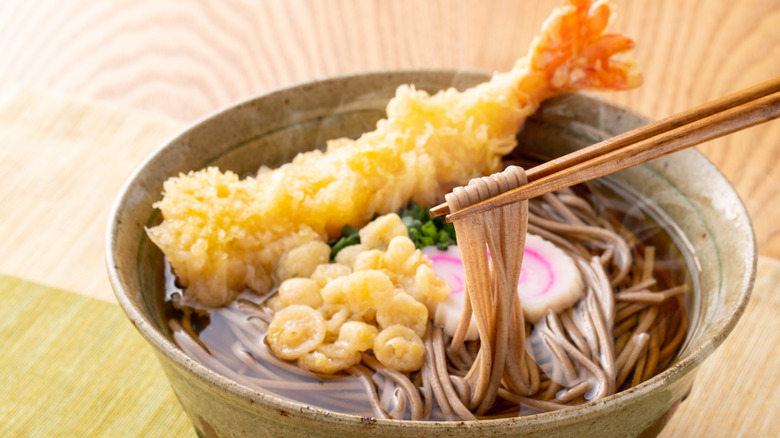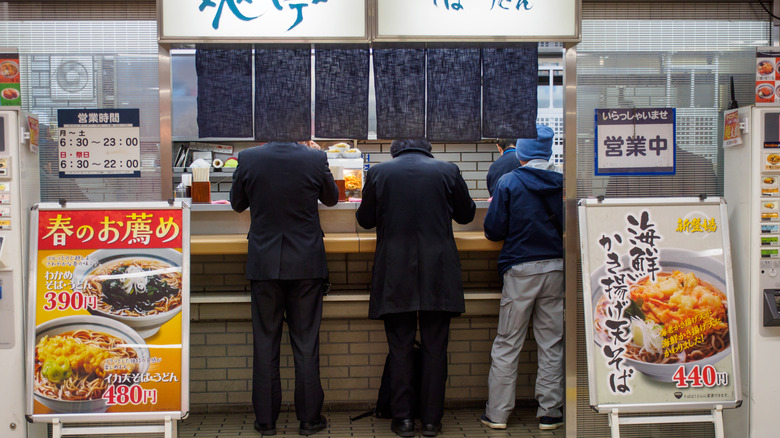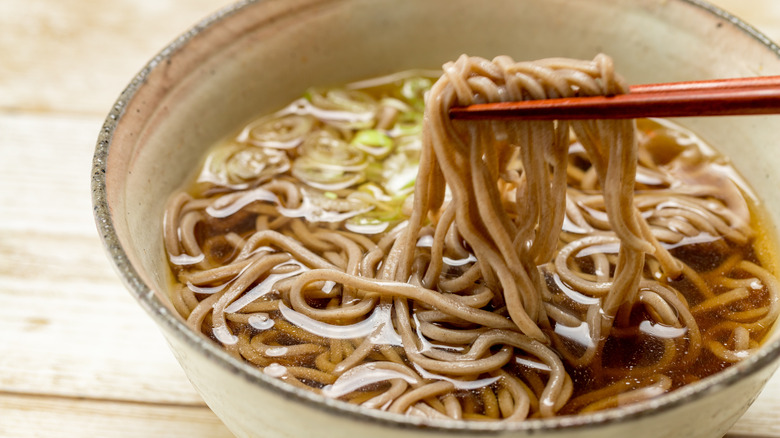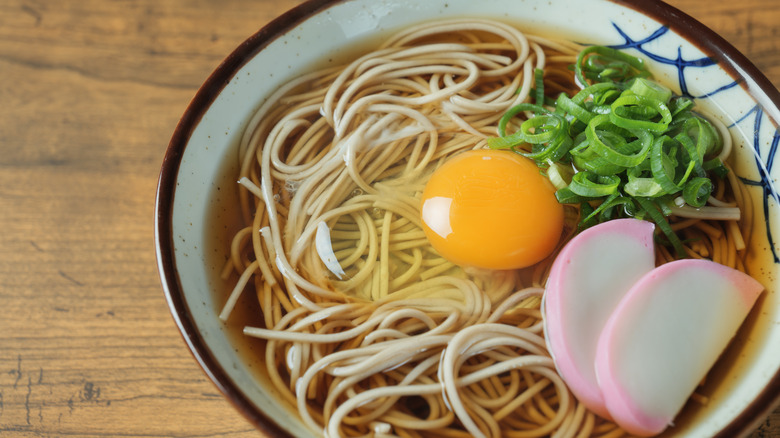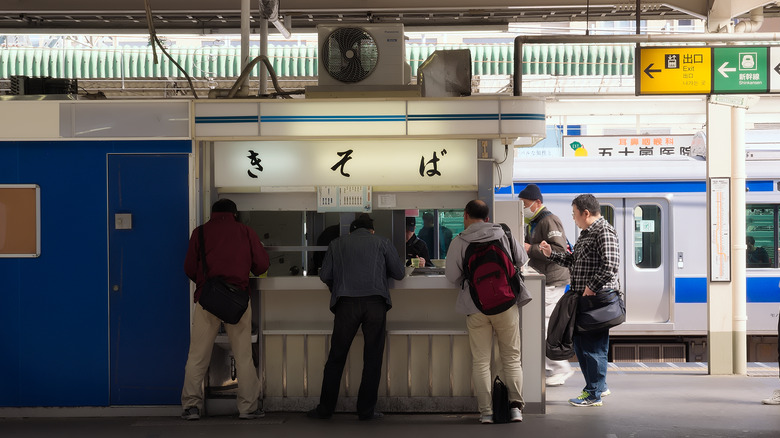Tokyo's Eki Soba Noodles Are A Train Station Delicacy
While a languorous, communal meal warms the heart, sometimes a quick bite is necessary. Chefs worldwide have perfected delivering food mere seconds after ordering, whether a sizzling al pastor taco or a swiftly-assembled satay. When it comes to Japanese food, ramen steals the show as the most famous convenience meal. However, various buckwheat-based soba noodles are also commonly eaten as fast food.
Known as eki soba, this unfussy dish brings together a simple broth, a few toppings, and tasty noodles for a nourishing meal. Eaten in standing-only restaurants called Tachigui, these fast-moving operations are especially intertwined with train stations. It's a favored breakfast for commuters before catching a train — ordered and slurped down in only a matter of minutes. And while the ingredient list may be short, the chef's deft combinations and efficiency make the dish stand out.
Ingredients in eki soba noodles
As per the name, this convenience meal starts with soba noodles. These buckwheat-based slivers of dough are not only delicious but also contain an abundance of nourishing plant compounds. Plus, they're a rare noodle dish that's totally gluten-free — just make sure to check the noodle producer hasn't blended in wheat flour for stability (via Health Line).
The noodles are served in a dark-colored broth consisting of soy sauce, fish stock, and cooking sake. Next, the noodles are accompanied by a range of toppings that are customizable when ordering. Common selections include kakiage, a tight-knit bundle of vegetable tempura, as well as raw egg, deep-fried tofu, wild forest vegetables, shrimp tempura, and tororo, which is a purée from a yam-like root called yamaimo. The dish is then finished with sliced green onion, as well as shichimi, a popular chili spice mix. For customers hoping to change up their noodles, the dish can often be substituted with udon.
How are eki soba noodles prepared?
In its simplest form, the dish is known as kake soba, devoid of topping. Preparing this fundamental base starts with assembling the broth. While exact ratios and components differ based on the chef, the dish follows a general form. Soy sauce, in both dark and light form, is combined with mirin and cooking sake and mixed into a dashi broth base. It's then simmered for a few minutes and often kept hot on the stove for a quick serving.
The soba noodles are simultaneously cooked in a separate pot. They're procured in different forms — some purveyors source fresh, frozen, dried, or even make their own. The fresher the noodle, the more aromatic the buckwheat flavor. Additionally, the soba must be cooked in a large volume of water to prevent stickiness.
Finally, the noodles are combined with the broth and garnished with toppings. To enable a quick turnaround, chefs often pre-cook the tempura and soba and warm them in the prepared broth. Such optimizations differ between every eki soba joint; many favor their own process for efficiency.
Eki soba variations
Varying renditions of the dish are classified based on the topping since most eki soba restaurants only prepare one type of broth. The most popular version of the dish comes with a large cooked shrimp called ebiten soba. Especially in the morning, diners also go for tsukimi soba, which translates to "moon viewing." This variation of the dish is served with a raw egg, which has a lunar-like appearance against the dark broth. Toppings can also reflect regional tastes and ingredients — like sansai soba with wild plants such as fern tips or bamboo shoots.
Noodle-makers also create seasonal interpretations of the dish. Famed chain Nadai Fuji Soba serves a cold noodle dish topped with fried soybean curd, imitation crabmeat, tempura bits, boiled egg, and wakame. The specials are often listed on posters outside the restaurants to attract customers. And with a low cost and quick turnaround time — why not give them a shot?
How eki soba noodles are served
The dish's quick-cooking nature and nutritious makeup make eki soba a morning meal, with eateries opening as early as seven in the morning. Served at stand-only restaurants known as Tachigui, these small countertop eateries are known for their affordable prices. While most known for their soba, these eateries also sell dishes like sushi, tempura, and steak.
Ordering the eki soba starts at a ticket machine, which usually only takes cash. You can select the noodle and broth types by a button; once paid for, the diner takes their receipt to the countertop, hands it to the waiter, and finds a space to stand. Within a couple of minutes, the steaming hot bowl of noodles appears and is slurped down before a train departure. It's considered polite to clean up any spillage and then depart swiftly after eating. Eki soba is not a social meal but instead is created as a comforting dish meant to be enjoyed on the move.
